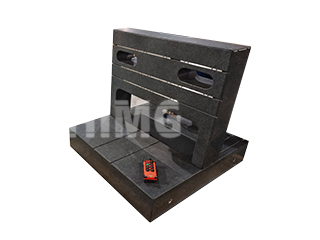The stability and accuracy of any ultra-precision machine—from large Coordinate Measuring Machines (CMMs) to advanced semiconductor lithography equipment—fundamentally rests upon its granite foundation. When dealing with monolithic bases of significant scale, or complex multi-section Granite Flat Panels, the assembly and installation process is as critical as the manufacturing precision itself. Simply placing a finished panel is insufficient; specific environmental and structural requirements must be met to preserve and utilize the panel’s certified sub-micron flatness.
1. The Foundation: A Stable, Level Substrate
The most common misconception is that the precision granite panel, such as those crafted from our high-density ZHHIMG® Black Granite (3100 kg/m³), can correct an unstable floor. While granite offers exceptional rigidity, it must be supported by a structure engineered for minimal long-term deflection.
The assembly area must feature a concrete substrate that is not only level but has also cured properly, often to military-grade specifications for thickness and density—mirroring the $1000mm$ thick, ultra-hard concrete floors in ZHHIMG’s own assembly halls. Crucially, this substrate must be isolated from external vibration sources. In the design of our largest machine bases, we incorporate concepts like the anti-vibration moat surrounding our metrology rooms to ensure the foundation itself is static and isolated.
2. The Isolation Layer: Grouting and Leveling
Direct contact between the granite panel and the concrete foundation is strictly avoided. The granite base must be supported at specific, mathematically calculated points to negate internal stress and maintain its certified geometry. This requires a professional leveling system and a grouting layer.
Once the panel is accurately positioned using adjustable leveling jacks or wedges, a high-strength, non-shrink, precision grout is pumped into the cavity between the granite and the substrate. This specialized grout cures to form a high-density, uniform interface that permanently distributes the panel’s weight evenly, preventing sag or distortion that could otherwise introduce internal stress and compromise flatness over time. This step effectively transforms the granite panel and the foundation into a single, cohesive, and rigid mass.
3. Thermal and Temporal Equilibrium
As with all high-precision metrology work, patience is paramount. The granite panel, the grouting material, and the concrete substrate must all reach thermal equilibrium with the surrounding operational environment before final alignment checks are performed. This process can take days for very large panels.
Furthermore, the leveling adjustment—performed using instruments like laser interferometers and electronic levels—must be done in slow, minute increments, allowing time for the material to settle. Our master technicians, who adhere to strict global metrology standards (DIN, ASME), understand that rushing the final leveling can introduce latent stress, which will surface later as accuracy drift.
4. Integration of Components and Custom Assembly
For ZHHIMG’s custom Granite Components or Granite Flat Panels that integrate linear motors, air bearings, or CMM rails, the final assembly requires absolute cleanliness. Our dedicated clean assembly rooms, which mimic semiconductor equipment environments, are necessary because even microscopic dust particles trapped between the granite and a metal component can induce micro-deflection. Every interface must be meticulously cleaned and checked before final fastening, ensuring the component’s dimensional stability is flawlessly transferred into the machine system itself.
By respecting these rigorous requirements, customers ensure they are not merely installing a component, but are successfully defining the ultimate Datum for their ultra-precision equipment—a foundation guaranteed by ZHHIMG’s material science and manufacturing expertise.
Post time: Oct-29-2025

